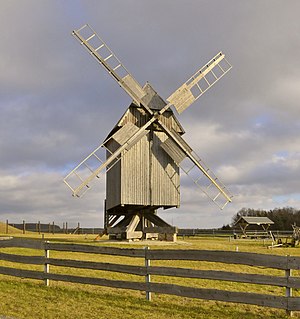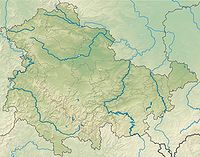Post mill Klettbach
| Post mill Klettbach
|
||
|---|---|---|
|
The Klettbach post mill (2011) |
||
| Location and history | ||
|
|
||
| Coordinates | 50 ° 55 '2 " N , 11 ° 9' 39" E | |
| Location | Germany | |
| Built | 1743/1909/2005 | |
| Status | Museum mill with an intact grinder | |
| technology | ||
| use | Flour mill | |
| Windmill type | Post mill | |
| Wing type | Door leaf | |
| Number of wings | 4th | |
| Website | http://www.bockwindmuehle-klettbach.de | |
The post mill in Klettbach is a special attraction and a landmark of this Thuringian community near Erfurt . It is located 500 m northeast of the village on a hill at a height of 437.7 m, making it the highest post mill in Germany.
history
The area between the mill and the state road L 2155, which slopes slightly to the north, is about 18 m away and is the Doberstedt desert . A smaller post mill was built here in 1810. However, it did not meet the requirements of the early 20th century. In the summer of 1909, the miller Osmund Hochstein from Klettbach arranged for the mill to be transported from Esperstedt ( Kyffhäuserkreis ), which was built in 1743. It was brought to Vieselbach by train, from where it was transported by horse to Klettbach and rebuilt about 120 m from its current location. The Mahlkundenbuch has made for 1913 that the mill to 162 days, the wind power for grinding or crushing could use of 178 tons of grain. The mill supplied the residents of Klettbach and the surrounding area, most recently in 1961 under the miller Karl Hochstein, with meal and flour. After that, the mill began to deteriorate.
In 1988 committed citizens of Klettbach joined forces in the Mühlenverein in order to preserve the building as a technical monument and Klettbach's landmark. In 2005, the mill was moved to its current location, where you could buy the property. On this occasion the mill was given new wings, was reconstructed and provided with a refurbished grinder.
Dimensions
The 28 t heavy mill stands on a base area of 6 × 6 m and is 14 m high, the blade diameter is 19 m. At an optimum wind speed of 8 to 10 m / s, the mill achieved a power output of 12 to 14 HP, which led to a grinding capacity of 75 to 150 kg / h of grain.
Web links
Individual evidence
- ↑ Information board at the mill

